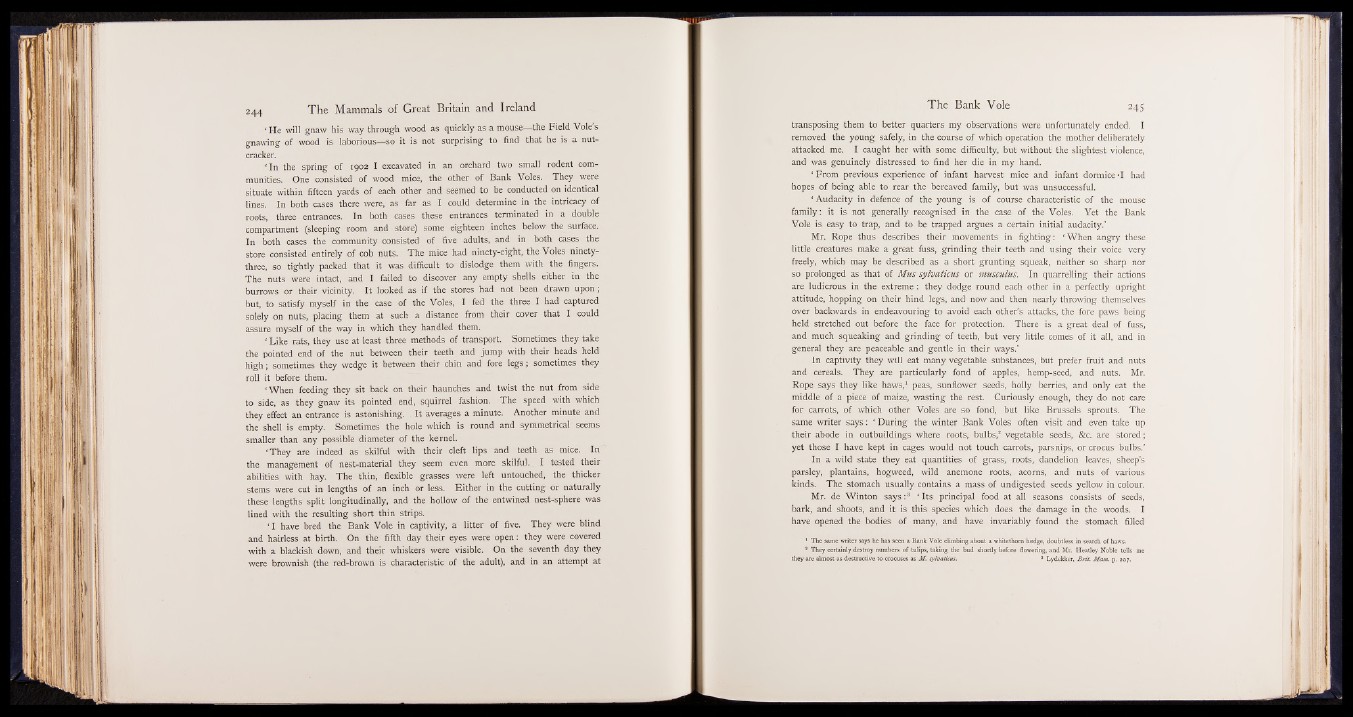
‘ He will gnaw his way through wood as quickly as a mouse—the Field Vole’s
gnawing of wood is laborious—so it is not surprising to find that he is a nut-
cracker.
‘ In the spring of 1902 I excavated in an orchard two small rodent communities.
One consisted of wood mice, the other of Bank Voles. They were
situate within fifteen yards of each other and seemed to be conducted on identical
lines. In both cases there were, as far as I could determine in the intricacy of
roots, three entrances. In both cases these entrances terminated in a double
compartment (sleeping room and store) some eighteen inches below the surface.
In both cases the community consisted of five adults, and in both cases the
store consisted entirely of cob nuts. The mice had ninety-eight, the Voles ninety-
three, so tightly packed that it was difficult to dislodge them with the fingers.
The nuts were intact, and I failed to discover any empty shells either in the
burrows or their vicinity. It looked as if the stores had not been drawn upon;
but, to satisfy myself in the case of the Voles, I fed the three I had captured
solely on nuts, placing them at such a distance from their cover that I could
assure myself of the way in which they handled them.
‘ Like rats, they use at least three methods of transport. Sometimes they take
the pointed end of the nut between their teeth and jump with their heads held
high; sometimes they wedge it between their chin and fore le g s ; sometimes they
roll it before them.
‘When feeding they sit back on their haunches and twist the nut from side
to side, as they gnaw its pointed . end, squirrel fashion. The speed with which
they effect an entrance is astonishing. It averages a minute. Another minute and
the shell is empty. Sometimes the hole which is round and symmetrical seems
smaller than any possible diameter of the kernel.
‘ They are indeed as skilful with their cleft lips and teeth as mice. In
the management of nest-material they seem even more skilful. I tested their
abilities with hay. The thin, flexible grasses were left untouched, the thicker
stems were cut in lengths of an inch or less. Either in the cutting or naturally
these lengths split longitudinally, and the hollow of the entwined nest-sphere was
lined with the resulting short thin strips.
‘ I have bred the Bank Vole in captivity, a litter of five. They were blind
and hairless at birth. On the fifth day their eyes were open: they were covered
with a blackish down, and their whiskers were visible. On the seventh day they
were brownish (the red-brown is characteristic of the adult), and in an attempt at
transposing them to better quarters my observations were unfortunately ended. I
removed the young safely, in the course of which operation the mother deliberately
attacked me. I caught her with some difficulty, but without the slightest violence,
and was genuinely distressed to find her die in my hand.
‘ From previous experience of infant harvest mice and infant dormice *1 had
hopes of being able to rear the bereaved family, but was unsuccessful.
‘ Audacity in defence of the young is of course characteristic of the mouse
family: it is not generally recognised in the case of the Voles. Yet the Bank
Vole is easy to trap, and to be trapped argues a certain initial audacity.’
Mr. Rope thus describes their movements in fighting: ‘ When angry these
little creatures make a great fuss, grinding their teeth and using their voice very
freely, which may be described as a short grunting squeak, neither so sharp nor
so prolonged as that of Mus sylvaticus or musculus. In quarrelling their actions
are ludicrous in the extreme: they dodge round each other in a perfectly upright
attitude, hopping on their hind legs, and now and then nearly throwing themselves
over backwards in endeavouring to avoid each other’s attacks, the fore paws being
held stretched out before the face for protection. There is a great deal of fuss,
and much squeaking and grinding of teeth, but very little comes of it all, and in
general they are peaceable and gentle in their ways.’
In captivity they will eat many vegetable substances, but prefer fruit and nuts
and cereals. They are particularly fond of apples, hemp-seed, and nuts. Mr.
Rope says they like haws,1 peas, sunflower seeds, holly berries, and only eat the
middle of a piece of maize, wasting the rest. Curiously enough, they do not care
for carrots, of which other Voles are so fond, but like Brussels sprouts. The
same writer say s : ‘ During the winter Bank Voles often visit and even take up
their abode in outbuildings where roots, bulbs,2 vegetable seeds, &c. are stored;
yet those I have kept in cages would not touch carrots, parsnips, or crocus bulbs.’
In a wild state they eat quantities of grass, roots, dandelion leaves, sheep’s
parsley, plantains, hogweed, wild anemone roots, acorns, and nuts of various
kinds. The stomach usually contains a mass of undigested seeds yellow in colour.
Mr. de Winton sa y s :8 ‘ Its principal food at all seasons consists of seeds,
bark, and shoots, and it is this species which does the damage in the woods. I
have opened the bodies of many, and have invariably found the stomach filled
1 The same writer says he has seen a Bank Vole climbing about a whitethorn hedge, doubtless in search of haws.
2 They certainly destroy numbers of tulips, taking the bud shortly before flowering, and Mr. Heatley Noble tells me
they are almost as destructive to crocuses as M. sylvaticus. 3 Lydekker, Brit. Mam. p. 207.